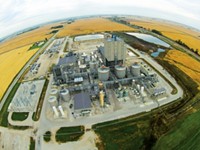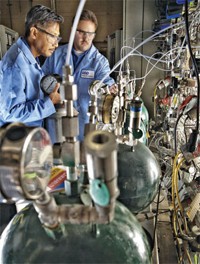Advertisement
Grab your lab coat. Let's get started
Welcome!
Welcome!
Create an account below to get 6 C&EN articles per month, receive newsletters and more - all free.
It seems this is your first time logging in online. Please enter the following information to continue.
As an ACS member you automatically get access to this site. All we need is few more details to create your reading experience.
Not you? Sign in with a different account.
Not you? Sign in with a different account.
ERROR 1
ERROR 1
ERROR 2
ERROR 2
ERROR 2
ERROR 2
ERROR 2
Password and Confirm password must match.
If you have an ACS member number, please enter it here so we can link this account to your membership. (optional)
ERROR 2
ACS values your privacy. By submitting your information, you are gaining access to C&EN and subscribing to our weekly newsletter. We use the information you provide to make your reading experience better, and we will never sell your data to third party members.
Business
New Life For Old Plants
Biodiesel has joined the mix of products that the chemical industry makes
by Alexander H. Tullo
February 12, 2007
| A version of this story appeared in
Volume 85, Issue 7

In the Summer of 2006, a consultant was combing Britain for second-hand storage tanks. He found them at a Lubrizol specialty lubricants plant that was shutting down in Bromborough on Merseyside. But more than just locating 25,000 metric tons of liquid storage capacity, he discovered a site that could be resurrected to produce the motor fuel known as biodiesel. He arranged a meeting between Lubrizol and biodiesel start-up D1 Oils, and by the end of September, D1 had agreed to purchase the facility for a mere $5.7 million.
The scenario is becoming common. Biodiesel is made in a straightforward transesterification reaction whereby methanol and oils from plants or animals are combined to make methyl esters—or biodiesel—and glycerin. The reaction can be done in many specialty chemical plants with only slight modifications. And with government incentives spurring growth in production of the fuel, chemical companies are finding biodiesel a worthwhile sideline or a new use for aging assets.
Such companies are using existing chemical capacity as a shortcut into a burgeoning sector that is attracting scores of new entrants. In the U.S., biodiesel production has grown at a meteoric pace for the past several years. According to Leland Tong of MARC-IV, a consulting firm retained by the industry group the National Biodiesel Board, U.S. biodiesel production in 2006 is estimated to be 250 million gal, a 230% increase from 2005 and a world away from the half-million gallons produced in 1999.
Capacity has moved up even more sharply. Some 105 plants in the U.S. have a combined capacity of 864 million gal per year, Tong says. And as many as 1.7 billion gal of new biodiesel capacity is planned over the next 18 months.
Tong attributes the strong increase in production and capacity to government incentives and high petroleum prices. In the U.S., the federal government offers companies that blend biodiesel a tax credit of $1.00 for each gallon of biodiesel blended into regular diesel, according to Josh Zahn, state regulatory manager for the biodiesel board. An additional 10-cent-per-gal tax credit is available to small biodiesel producers.
Eleven states, including Texas and Arkansas, offer incentives for biodiesel producers, and still others offer incentives to retailers, Zahn says. For instance, Illinois law exempts the biodiesel portion of fuel blends containing more than 10% biodiesel from state motor fuel taxes, causing a flowering of 11% blends there.
Ed Greene, commercial director for Dow Haltermann Custom Processing, says biodiesel makers couldn't manage without such government help. "Without incentives, there are few scenarios where biodiesel can truly be competitive with diesel," he says. "For the most part, biodiesel, not unlike ethanol, needs government subsidies or some kind of help to be economically viable."
The U.S. isn't alone in promoting biodiesel. For example, the U.K. mandates that motor fuels must have a 5% renewable component by 2010. D1 Oils expects this rule and related incentives to push biodiesel demand there to about 300 million gal per year.
Generous incentives on both sides of the Atlantic have spurred a spate of chemical plant conversions. For example, U.S. start-up FutureFuel raised $180 million on the London Stock Exchange's Alternative Investment Market last year by promising to use the funds to buy chemical plants and convert them to biodiesel production. Last October, the company paid $75 million for Eastman Chemical's Batesville, Ark., specialty chemical plant, which already had 24 million gal per year of biodiesel capacity.
Another former Eastman facility—a Moundville, Ala., resins plant that closed in 2002—reopened in 2004 as a 10 million-gal biodiesel plant. And the surfactants producer Stepan has added 22 million gal of biodiesel capacity at its Millsdale, Ill., chemical plant.
Observers say chemical plants can be used to enter the biodiesel market cheaply and quickly. Paul Bottrill, business development manager for D1, reckons that building the Bromborough site from scratch—including the hardware, logistical connections, offices, labs, and parking lot—would have cost up to $80 million.
To D1, the site offered a head start. "The batch processes that D1 intends to use on the site are similar to the batch processes that Lubrizol operated for a number of years," Bottrill says.
The company intends to install 30 million gal of biodiesel capacity at Bromborough by the end of 2007. The first 15 million gal will come, Bottrill says, from using Lubrizol's old equipment already at the site. The subsequent 15 million gal will require new equipment, similar to what D1 operates at a 10 million-gal plant in Middlesbrough, England.
In all, the cost of bringing onstream the 30 million gal of capacity is expected to be about $30 million. In contrast, it cost the company $14 million to get 10 million gal of capacity running at Middlesbrough, a former ironworks and munitions plant.
Bottrill says the new capacity will come on-line at least a year more quickly than if D1 had built the entire facility new. For instance, environmental permits transferred from Lubrizol spared D1 up to 18 months to get new ones.
Speed to market and minimal investment attracted Dow Haltermann to biodiesel, Greene says. In late 2004, the company began making the fuel for biodiesel producer and distributor World Energy. He notes that Dow Haltermann's business is helping chemical makers introduce new products or bring on incremental capacity in a hurry. "At the time, World Energy was looking for additional biodiesel capacity, which was a good fit for our business model and asset base."
Greene says it took only 120 days from the initial meetings with World Energy to the first deliveries of biodiesel from Dow Haltermann's Houston plant. And, he says, Dow Haltermann did not have to make special investments to start making the fuel, though it has spent modest amounts since then on efficiency improvements. Dow Haltermann is already considering an expansion of the 20 million gal of biodiesel capacity it operates in Houston.
Oleochemicals maker Peter Cremer has also taken advantage of the high speed to market and low investment costs that chemical plants offer biodiesel players. In 2002, Peter Cremer began making its biodiesel by toll manufacture at a former Procter & Gamble oleochemical plant in Corsicana, Texas, owned by Corsicana Technologies.
Cremer grew out of that facility the following year, and now its product is being made at a plant owned by Twin Rivers Technologies in Cincinnati, says Howard M. Findley, Cremer's North American sales manager. "We utilized their open methyl ester capacity to produce biodiesel," he says. Last year the company spent a mere $6 million to double capacity at the plant to 30 million gal.
Meanwhile, Huish Detergents got into the biodiesel business as an outlet for chemicals it was already making. The detergents company produces its own methyl ester-based surfactants from palm oil at a five-year-old plant in Pasadena, Texas. "We had a methyl ester that couldn't be used as a surfactant," says Evan Frampton, senior vice president at Huish. "So we decided to get into biodiesel as well."
The company's 4 million gal of biodiesel capacity came at no special investment. "We didn't have to make any changes to our plant," Frampton says. "We have a fractionation column where we fractionate the palm oil, part of which we use for detergents and part of it for biodiesel."
Yet chemical makers' strength in biodiesel is not solely a result of advantages in cost and speed to market. MARC-IV's Tong points out that chemical companies are adept at manufacturing to rigorous specifications and often have quality control labs right on-site. He adds that they generally have an easier time meeting the National Biodiesel Board's BQ-9000 quality standards for diesel fuel because the standards are similar to ISO 9000 quality standards used in the chemical industry.
In addition, Greene says, chemical plants are set up to handle the logistics of working with hundreds of millions of pounds of feedstocks per year. "Those are the types of capabilities that most chemical plants already have," he says.
Moreover, chemical companies are more suited to upgrading the glycerin coproduct than are newcomers to chemical synthesis, Greene says. For instance, Dow Haltermann's parent, Dow Chemical, is considering building a plant in China that would convert glycerin into epichlorohydrin. Chemical companies are also considering making propylene glycol from glycerin. "Biodiesel facilities in Europe and North America have dramatically increased the availability of glycerin," Greene says. "A chemical company might be in a good situation to derivatize the glycerin into something of higher value."
It's not all good news for chemical companies and biodiesel, however. In recent months, soybean oil prices have risen while diesel prices have slipped, making the biodiesel business much less profitable than it was only a half-year ago. Cremer's Findley says declining prices for glycerin and increasing prices for methanol have also left a mark.
MARC-IV's Tong figures that if oil prices hit $65 per barrel again, biodiesel production could grow by another 250 million gal. But if oil prices erode to $45 per barrel, companies might reevaluate plans to enter the market.
One biodiesel maker already has. Last month, FutureFuel canceled plans to increase capacity to 40 million gal by May and 160 million gal by November. Between the end of October and the middle of January, the company says, rising soybean oil and declining diesel fuel prices shaved about 25 cents per gal off of biodiesel profits.
The situation may become more critical in the near future as biodiesel producers bid up the price of edible oils such as soybean and palm, Tong says. Over the longer term, he adds, high prices for edible oils may spur alternative raw materials. In fact, D1 has already planted or obtained the rights to 125,000 hectares of the nonedible oil seed crop jatropha in India, East Asia, and Southern Africa.
And Tong notes that while chemical plants do have many advantages in the biodiesel business, they are typically not tied into soybean-crushing facilities. The agricultural conglomerate Cargill, for example, operates a 40 million-gal biodiesel plant in Iowa Falls, Iowa, associated with a company-owned soybean-processing plant.
Such an advantage, Tong notes, could come in handy as edible oils become scarcer. "If you are tied to a big crushing facility, you know you will have a supply of oil," he says.
Beyond any business advantage, D1's Bottrill says he gets satisfaction from putting an old chemical plant and some of its employees back to work again. He says the Bromborough plant would have gone to waste had D1 not stepped in. "They were going to demolish the site, clear it, clean it up where required, if at all, and then the developer would have walked in and built a warehouse on it," he says. "We were light at the end of the tunnel for the local community."






Join the conversation
Contact the reporter
Submit a Letter to the Editor for publication
Engage with us on Twitter